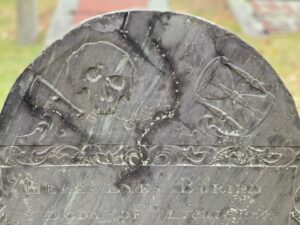 When the genealogy bug hits, one of the earliest field trips a budding genealogist makes is to a cemetery. Cemeteries are rich in history. The grave marker inscriptions reveal our ancestor’s death date, and perhaps age at death or date of birth. If we are fortunate, we also learn the names of spouses, maiden names, and names of children in a cemetery.
When the genealogy bug hits, one of the earliest field trips a budding genealogist makes is to a cemetery. Cemeteries are rich in history. The grave marker inscriptions reveal our ancestor’s death date, and perhaps age at death or date of birth. If we are fortunate, we also learn the names of spouses, maiden names, and names of children in a cemetery.
But how many of us pay attention to the grave markers themselves? There are substantial differences in the markers of the colonial period and the stones of later centuries. The earliest grave markers were the simple wooden cross or a piece of field stone. When the first carved headstones were created, they were made of stone that was both local and easily quarried and carved. So slate, sandstone, limestone, and even soapstone were typical materials. The stones were placed at the head of the deceased and the grave was oriented east to west so that at the Last Judgment, the deceased could sit up and face the East.
Early markers, particularly Puritan New England markers, showed a Death’s Head with wings and an empty triangular nose where flesh and cartilage had rotted away. Puritans were fearful of death, as there was no guarantee that God would forgive their sins after death and welcome them to heaven. Puritans also did not believe in making any lifelike representation of the divine, hence the unlifelike skull adorning the grave markers. Beginning about 1690, however, the cherub face begins to appear in place of the skull on grave markers. The cherub design is clearly a recognizable human face and the wings on this design represent the soul’s ascension to heaven.
Puritans were fearful of death, as there was no guarantee that God would forgive their sins after death and welcome them to heaven.
By the eighteenth century, grave markers became taller and new shapes appeared. The seventeenth-century grave marker featured a rounded tympanum and knobby shoulders over a rectangular tablet. Some of the eighteenth-century stones did away with the rounded tympanum and simply became rectangular. For stones that retained the tympanum, the rounded shoulders might be gone, creating a squarer shape. Inscriptions in the eighteenth century began to move away from admonitions on the brevity of life and the certainty of decay to inscriptions that were addressed to the mourners.
New symbols appeared in conjunction with the ever-popular Death’s Head. An hourglass might be added to the decoration, symbolizing the rapid passage of time with death at the end. Or perhaps a pair of crossed bones would be added to warn that we are all mortal and will die. Mid-century, urns appeared. Urns were symbolic reminders of the practice of cremation, where the body returns to dust, but the soul is everlasting and with God. Towards the end of the century the willow tree with an urn became a prominent grave marker symbol. The willow tree with its downward arching branches touching the ground represented eternal weeping and grief. The living left behind will always mourn the deceased, who now rests with God.
The nineteenth century saw dramatic changes in grave markers, especially during the reign of Queen Victoria. In addition, the cemetery, that is a planned burial ground, emerged during the nineteenth century. Cemetery is from a Greek word that means “sleeping place.” As methods of transportation improved, heavy marble became a popular stone.
As methods of transportation improved, heavy marble became a popular stone.
Grave marker symbols in the nineteenth century were less grim and focused more on hope and individualism. They also become more complex. A sleeping child might be added to a monument, symbolizing an infant or child death. Victorian markers often layered blocks of stone, creating elaborate bases for a stone cross. Flowers, especially lilies – an image of purity, Easter, and resurrection – might adorn markers. Or perhaps oak leaves, symbolizing strength, endurance, faith, and virtue. By the end of century, some markers imitated Egyptian funeral symbols as archeological expeditions to the Nile River uncovered the amazing tombs of ancient pharaohs.
The twentieth century saw the widespread use of durable granite as tools and techniques for carving and etching granite evolved. Symbols used in the twentieth century were as varied and diverse as the individual whose grave was being marked. The symbols speak of the individual’s community and beliefs.
Next time you walk into a cemetery, take a look around. Where are the thin slate markers? Where are the stocky granite markers? You should be able to tell at a glance which section of the cemetery is oldest by examining the markers.
Share this:

About Ann Lawthers
Ann G. Lawthers assists our library patrons in enhancing their research skills and in bringing alive their family histories. She is a graduate of Wellesley College, the Harvard School of Public Health and has completed the Boston University Certificate in Genealogical Research program. She has conducted genealogical projects as an independent researcher. Ann is familiar with resources for Massachusetts, Vermont, Pennsylvania, Maryland, New Jersey; and has research experience with Quebec and the Canadian Atlantic Provinces, Ireland and Germany.View all posts by Ann Lawthers →